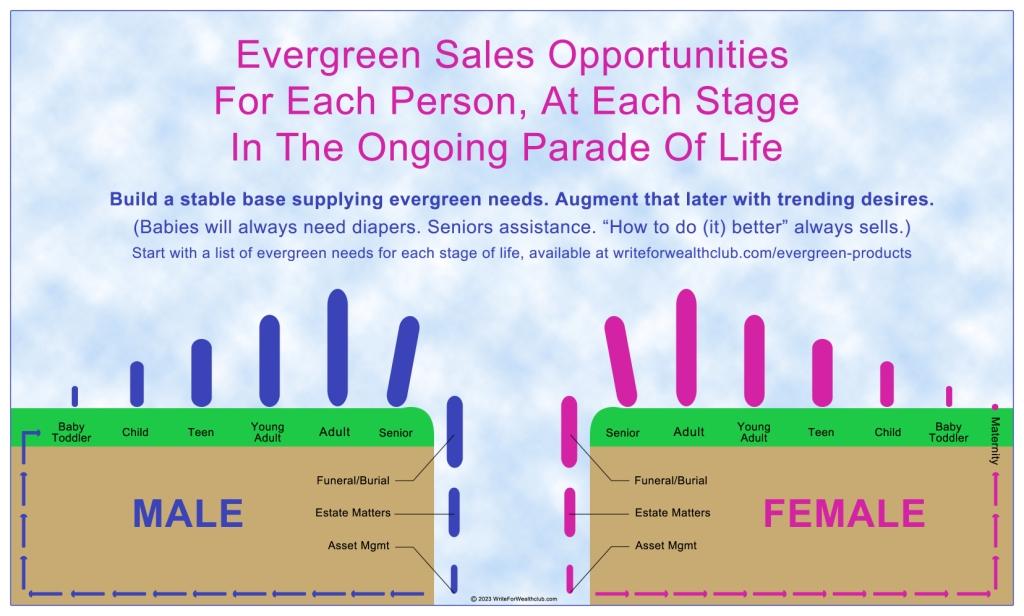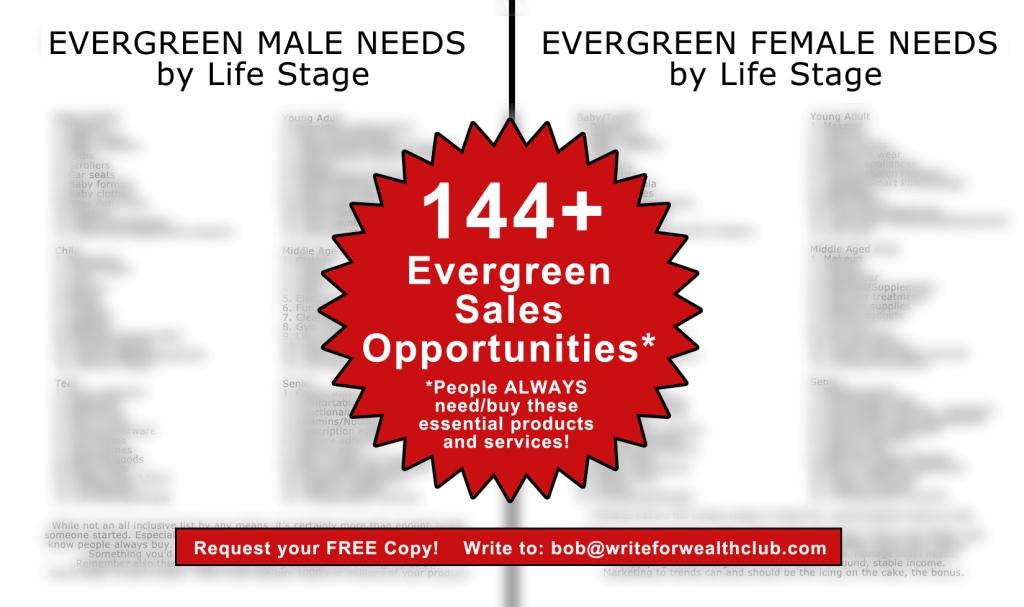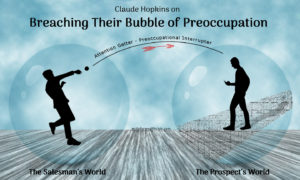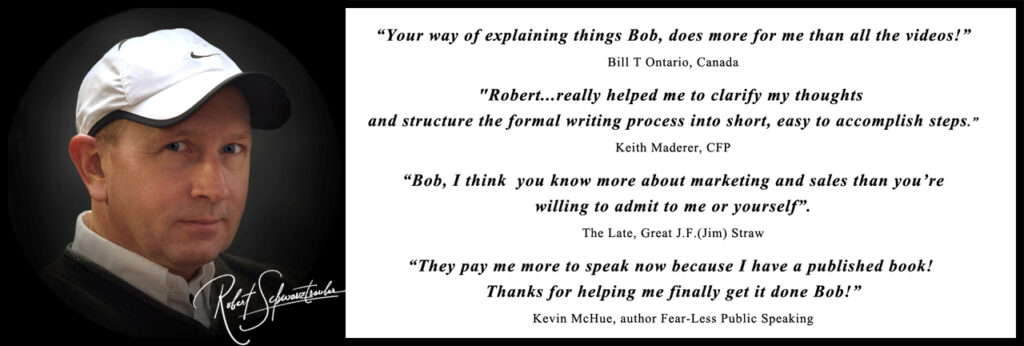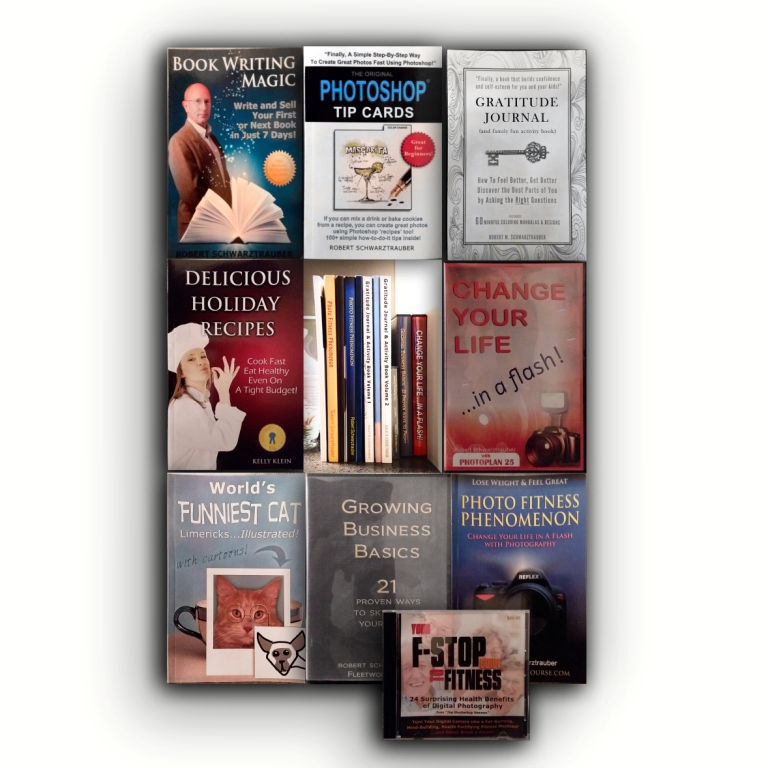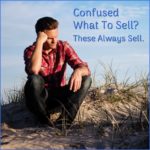
Here’s What to Sell Online When You Don’t Know What to Sell
So you want to start an online business, but you aren’t sure what to sell?
I get it.
When I first started out as a writer, I had no clue what info products would be useful for my audience (wait, let’s be honest – I didn’t even have an audience!). I didn’t know what to sell.
Luckily, I found there are many evergreen options which pretty much always work when you’re selling digital products online.
Things like eBooks, video training courses, templates, and more. These are products buyers tend to need again and again, so the demand stays consistent over time. Which means you have an opportunity to make stable, consistent money over time, rather than quick, one-off sales spikes and then nothing.
Why Evergreen Products Sell
We humans move through several, predictable stages in our life. And each stage requires certain predictable products and services. One of the simplest is, babies need diapers. Always. That’s a reliable physical product category. Parents of babies will ALWAYS be looking for info on how to be a good parent. That’s a reliable digital information product.
For each stage in our life, this pattern repeats. There are things each group ALWAYS buys.
And when folks reach the end of life, look again. Another group of babies has been born. This repeats on a daily basis. There are ALWAYS new evergreen customers seeking to buy evergreen products.
If you are at a loss for what to sell, why not sell things people ALWAYS buy?
Evergreen Example: Photoshop Tutorial Book
For example, one of the very first books I self-published was an entry-level, short book on the most popular, and highly praised photo editing software, Photoshop.
Mind you, I was no expert at that. 6 months experience was all I had. All I COULD write was a basic, entry level book on Photoshop. Yet that’s OK.
You don’t need to be THE expert. Unless your prospects are Photoshop masters looking to learn the most advance techniques. All you need is to be better than those at a level below you. That’s your prospects. And often, as was my case, being the “newbie” helps you present information from a simple, beginners perspective.
Often, when experts with years and years of experience try to teach something, they assume you already know a bunch of stuff. Then, as a less skilled than assumed student, you get lost, confused and quit.
Remember, if you are just a level above someone, you can teach THEM. Not everyone. But Them.
This is an important point many don’t consider. But knowing only that – opens up tremendous opportunities.
Back to my story…
As most know, Photoshop has a reputation for requiring a fairly steep learning curve. I initialy struggled with it myself, until I developed some shortcuts. My first book, “Photoshop Tip Cards” included those shortcuts to help aspiring photographers. It’s been consistently selling, in the older, and now the newer paperback format for over ten years now.
Why?
Because there is always a new crop of photographers coming up who need to learn and use Photoshop.
“Bob, your way of explaining things does more for me than all the videos.” wrote one buyer.
Photographers are an evergreen hobby market. There have been photographers since the first camera was invented in the early 1800’s. The ubiquity of smartphone cameras, in addition to dedicated digital hobby and professional cameras, has only expanded the need to edit photos. Despite all the many easy apps to edit photos now available, and other Photoshop copycats, Photoshop remains THE go-to editor for professionals and hobbyists who desire high quality photographs and graphic images.
Such is the value of choosing an evergreen market.
Don’t overthink your products, what to sell, too much.
Concentrate on finding hot evergreen topics people always need help with. Then, look at the skills you already have that you can teach in a simple systemized way. Or find someone to partner with who can, and package that knowledge up into an eBook, videos, templates or other appropriate products and services.
What if I don’t want to create products?
No problem! If you don’t want to create products you have several other options:
-
- Find and Use PLR (private label rights) content and sell it simply on sites like Gumroad
- Do Affiliate Marketing – use affiliate commision sites like Clickbank, or programs directly from sellers. You can find these by looking at the bottom of their website page for the word “affiliate”.
- Promote Online Learning Courses thru their affiliate programs, sites like Skillshare, Udemy, Coursera all have them
- Promote Amazon products through their affiliate program
These days, there are plenty of existing products and services you can promote without ever having to create your own. The only downsides to relying on other people’s products are control and profits. With affiliates, you’ll have less of both. But this is often offset by ease of sale, quantity and variety of things to sell, and greater speed to market potential.
There are TONS of great products out there, old and new, foreign and domestic that are collecting dust instead of cash because the creators were clueless about marketing. Could you help them?
Ask!
With a little hustle to get the word out, you’ll can be up and running with digital products in no time! Today even.
Remember, focus on markets (the who), their needs and problems first – because you want to be selling irresistable solutions to evergreen problems and markets.
You want to be in the business of selling evergreen products. The competition IS greater, but so is your potential for reliable profits and ultimate stability and success.
To make this easy as pie for you, I’ve created a list of 144+ Evergreen Opportunities which span the life cycle of men and women from conception until death.
Anytime you’re stumped for what to sell, simply glance over this list sheet to quickly get those money gears turning again. You can’t help but to think of something someone needs, that you could sell them when you simply glance over this sheet.
You want it? I’ll send it to you for FREE. Simply send an email request to me, bob@writeforwealthclub.com
Be sure to put Evergreen in the subject line to get your opportunities sheet faster.
That’s all for today folks.
Happy Selling and Happy Holidays!
– Robert Schwarztrauber
P.S. Remember that at each stage of life, new people (prospects) are always coming online. Your prospects are in a march, a parade. They are always in motion – even if you can’t perceive it. They are moving toward something (goals) or away from something (fears). Life moves pretty fast, as Ferris Beuller says. Your targets are moving. One day they buy diapers, soon enough they have no use for them. One day they don’t need a car, next day their’s got totalled in a crash, and now they do. You’re moving. They’re moving. Keep shooting. Reload. Best to have a lot of evergreen products (ammo) on hand so you never miss an opportunity to hit it big. And digital products cost nothing to store. Hmmm?
P.P.S. The Copywriter’s Persuasion Toolkit lets you see specifically which products are most likely to sell to any specific market and the emotional hotbuttons you will need to trigger quick and reliable sales.
